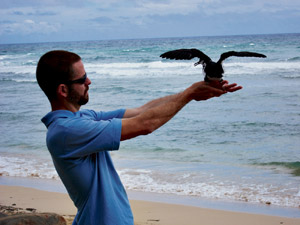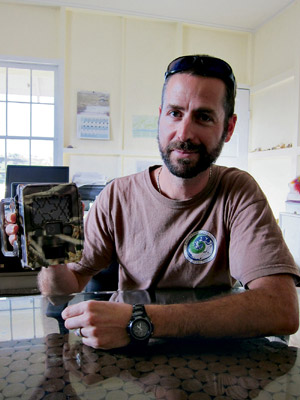Candid Camera For Endangered Birds
New technology is making it easier for humans to protect native Kaua’i seabirds by better understanding their behaviorsThe native birds of Kaua’i are in grave danger, but they have some dedicated friends in the Kaua’i Endangered Seabird Recovery Project (KESRP). For the Hawaiian petrel (‘ua’u), Newell’s shearwater (‘a’o) and the band-rumped storm petrel (‘ake ‘ake), that means hope for many of their generations to come.
The group plays a significant role in efforts to slow the rate of population decline. The team of scientists, headed by Andre Raine, is using state-of-the-art technology to gather data on the birds so that problems are better understood and solutions are established.
“It’s at a point where we need to come to a turnaround, otherwise this decline is just going to keep going,” says Raine. “It would be a huge loss for the island.”
By increasing their knowledge of the birds’ behavioral patterns, scientists can produce long-term management plans to help ensure their continued survival.
This year, for example, cameras were able to monitor birds at nesting sites including upper Limahuli Valley, and have provided never-before-seen footage.
“It’s just revealing the secret life of these birds,” says Raine.
A camera’s infrared sensor picks up any movement and, when triggered, fires off a rapid succession of pictures while remaining invisible to the bird.
“So it’s almost like watching a video,” explains Raine.
By learning how much time the birds spend at their burrows, accurately establishing the time of year they arrive and depart, and figuring out how often they are visited by rats and cats, KESRP can develop methods to help protect them. Determining when the birds spend most of their time at their burrows during the year, for example, would assist scientists in creating a way to deal with introduced predators.By collecting data such as the exact moment chicks emerge from their burrows, translocation techniques also may be cultivated, where the babies can be placed into other colonies to help increase their survival rate. This is something that must be done before they emerge, as once they come out of their burrow they become “fixated” on their colony.
The videos also reveal just how meticulous the birds are about keeping their burrows clean, and the intimate interactions between adults and babies.
“It shows people a side of the birds nobody really gets to see,” says Raine. “It’s really amazing to see them interact naturally.”
In fact, this is the first time Newell’s shearwaters have been observed this way. The only time people really get a chance to see these birds are when fledglings have fallen to the ground on their way out to sea because of lights and power lines. They are almost always lost and frightened in the midst of an unnatural concrete jungle.
“Here, you’re going to see them doing their own thing,” says Raine.
Another new method of collecting seabird data this year includes radar tracking of seabird fledglings leaving their burrows during the month of October (they fledge between the months of September and December). Previously, radar work only was collected annually in June when adults had returned to their colonies to breed after being out at sea for several months. This annual data already indicated the Newell’s shearwaters population has dropped some 75 percent over the last 15 to 20 years. Now, additional data can be collected regarding decreasing numbers of fledglings leaving their burrows for the first time.
“Projections don’t look great at the moment,” says Raine.
But mitigation efforts are already under way, thanks to KESRP and other entities, including Kilauea Point National Wildlife Refuge. This year, at least 11 pairs of ‘a’o returned to the refuge to breed, the highest number ever recorded.
Typically, the birds nest in the interior mountains and valleys, but they have a greater chance of survival by nesting at the Kilauea coastline because they don’t have to overcome barriers buildings, bright lights and utility wires.
During the 1980s, the translocation project began where some Newell’s shear-waters eggs were removed from mountain colonies and placed into the nests of the wedge-tailed shearwaters (‘u’au kani) in Kilauea.
The project only recently has become more successful because of a sound system placed around the refuge in 2007 by KESRP, in collaboration with the refuge, that produces the calls of the ‘a’o in order to attract them back to the area.
Conserving these birds through efforts like this is vital to the health of the island. Nutrient cycling is just one example of their environmental importance.
“It’s something a lot of people don’t even think about,” says Raine. “Part of Kaua’i is this constant, never-ending movement of the seabirds bringing nutrients from the sea back up to the mountain.”
Moreover, the seabirds are true Kauaians.
“If they go extinct here, they are gone,” he says.
Coming across a crushed Newell’s shearwater fledgling on the road is heartbreaking for Raine because it’s not just the loss of the bird’s life; it’s the loss of its entire survival to get to that point as well as its parents’ committed investment.
Not only do fledglings spend their first three or more years out at sea, but once they return to their colony, there is no guarantee of a viable hatchling.
“If you think about all of the trials and tribulations these birds go through all the way through their breeding season,” says Raine, “it would give people a good perspective on why they’re important and why they should be saved.
“This is Kaua’i’s bird, so we have to feel an ownership and responsibility as well.”
Visit kauaiseabirdproject.org for more information.





